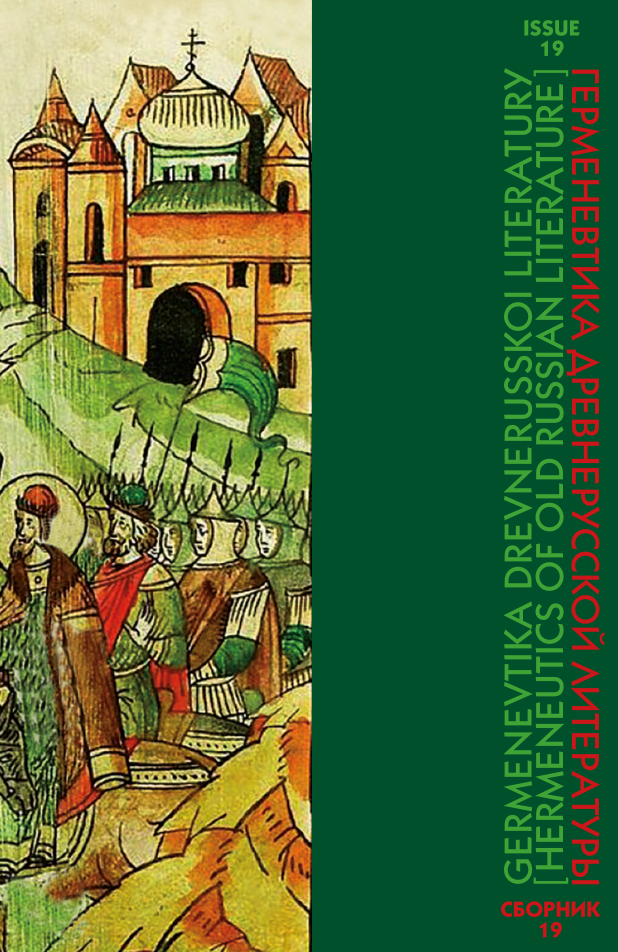Abstract:
The paper examines the symbolic meanings of visual metaphor of “sword” in an iconographic composition of title page frame of book by Lazar Baranovich Spiritual Sword (1666). This metaphor correlates with the main literary image of book interpreted by Lazar as Word of God, acting as an instrument of struggle between Good and Evil in the End Times. The plot of title page is primarily associated with the Preface to the Reader, but, moreover, it is not an accurate and complete illustration. Lazar Baranovich does not explain in detail the deep eschatological meaning of the title’s microplots. Instead, with help of the text of Preface and the visual language of engraving, he engages the reader in theological and intellectual play of images and metaphors. The symbolism of sword, based on quotations from Scripture, is complex, varied and ambivalent. But the inscriptions accompanying the images constantly emphasize that the swords present here are, first of all, metaphors of speech. They, like the harp peeping out of the back of King David, can be used to preach spiritual truth and expose verbal lies, which, like a sword, are wielded by opponents of the true faith.
REFERENCES
1 Abramenko, N.M. “Graviura iz knigi Lazaria Baranovicha ‘Mech dukhovnyi’ v kontekste russkogo iskusstva vtoroi poloviny XVII v.” [“An Engraving from Book ‘Spiritual Sword’ by Lazar Baranovich in the Context of Russian Art of the Second Half of the 17th Century”]. Chetvertye Kazanskie iskusstvovedcheskie chteniia. Iskusstvo pechatnoi grafiki: istoriia i sovremennost’. Materialy Vserossiiskoi nauchno-prakticheskoi konferentsii s mezhdunarodnym uchastiem. 19–20 noiabria 2015 g. [The Fourth Kazan Art History Readings. The Art of Printed Graphics: History and Modernity. Materials of the All-Russian Scientific-practical Conference with International Participation. 19–20 November 2015]. Kazan, Zaman Publ., 2015, pp. 8–11. (In Russian)
2 Berman, A.G. “Khristos-kupets i korabl’-tserkov’. K voprosu ob istochnikakh khlystovskogo motiva o ‘Bogatom goste’.” [“Christ the Merchant and the Ship-Church. On the Question of the Sources of the Khlysts Motive about the ‘Rich Guest’.”]. Dorozhno-transportnyi kompleks: sostoianie, problemy i perspektivy razvi tiia: sb. nauchnykh trudov [Road Transport Complex: State, Problems and Development Prospects: Collection of Scientific Papers], part 1. Cheboksary, Volzhskii filial MADI Publ., 2017, pp. 11–21. (In Russian)
3 Gladkov, A.K. “‘Hunc ergo gladium de manu Ecclesiae accipit princeps…:’ formula razdeleniia vlastnykh polnomochii v politicheskoi mysli srednevekovoi Evropy” [“‘Hunc ergo gladium de manu Ecclesiae accipit princeps…:’ Formula for the Separation of Powers in Political Thought of Medieval Europe”]. “Vertograd mnogotsvetnyi.” Sbornik k 80-letiiu Borisa Nikolaevicha Flori [“Multicolor vertograd.” Collection for the 80th Birthday of Boris Nikolaevich Florya]. Moscow, Nauka Publ., 2018, pp. 37–48. (In Russian)
4 Gombrich, Ernst. Simvolicheskie obrazy. Ocherki po iskusstvu Vozrozhdeniia [Symbolic Images. Essays on Renaissance Art], trans. E.M. Dobrokhotova-Maikova. St. Petersburg, Aleteiia Publ., 2017. 408 p. (In Russian)
5 Dembo, L.I. “‘Saksonskoe zertsalo’ — vydaiushchiisia pamiatnik istorii germanskogo feodal’nogo prava” [“‘Saxon Mirror’ — an Outstanding Monument to the History of German Feudal Law”]. Saksonskoe zertsalo. Pamiatnik, kommentarii, issledovaniia [Saxon Mirror. Monument, Commentary, Research]. Moscow, Nauka Publ., 1985, pp. 152–225. (In Russian)
6 Makarova, I.S. “Mifopoeticheskii obraz korablia durakov v iskusstve Severnogo Vozrozhdeniia (analiz poemy S. Branta i kartiny I. Boskha)” [“Mythopoetic Image of Ship of Fools in the Art of the Northern Renaissance (Analysis of the Poem by S. Brant and Paintings by I. Bosch)”]. Izvestiia Rossiiskogo gosudarstvennogo pedagogicheskogo universiteta im. A.M. Gor’kogo. Obshchestvennye i gumanitarnye nauki, no. 171, 2014, pp. 108–115. (In Russian)
7 Matushek, E.Iu. “‘Zapadniki’, grekofily i traditsionalisty kak chitateli ‘Mecha dukhovnogo’ Lazaria Baranovicha” [“‘Westerners’, Grekophiles and Traditionalists as Readers of the ‘Spiritual Sword’ by Lazar Baranovich”]. Literaturovedcheskii zhurnal (Materialy III mezhdunarodnogo simpoziuma «Russkaia slovesnost’ v mirovom kul’turnom kontekste») [Literary Journal (Proceedings of the III International Symposium “Russian Literature in the World Cultural Context”)], no. 28, 2011, pp. 17–24. (In Russian)
8 Pastoureau, Michel. Simvolicheskaia istoriia evropeiskogo srednevekov’ia [Symbolic History of the European Middle Ages], trans. E.S. Reshetnikova. St. Petersburg, Aleksandriia Publ., 2019. 448 p. (In Russian)
9 Poldnikov, D.Iu. “Dvukh mechei teoriia” [“Two Swords Theory”]. Pravoslavnaia entsiklopediia [Orthodox Encyclopedia], vol. 14. Moscow, Tserkovno-nauchnyi tsentr “Pravoslavnaia entsiklopediia” Publ., 2007, pp. 270–271. (In Russian)
10 Sukina, L.B. “‘Rod tsarstviia blagoslovitsia:’ dva sluchaia interpretatsii bogoizbrannosti praviashchego doma Romanovykh v russkoi khudozhestvennoi kul’ture vtoroi poloviny XVII – nachala XVIII v.” [“‘The Kin of the Kingdom Will Be Blessed:’ Two Cases of Interpretation of the Choice of God of the Romanov House in the Russian Artistic Culture of the Second Half of the 17th — Early 18th Centuries”]. Vestnik RGGU. Seriia Literaturovedenie. Iazykoznanie. Kul’turologiia, no. 3, 2020, pp. 115–131. (In Russian). DOI: 10.28995/2686-7249-2020-3-115-131
11 “Ukrainskie knigi kirillovskoi pechati XVI–XVII vv. Katalog” [“Ukrainian Books of Cyrillic Print of the 16th–17th Centuries. Catalogue”], comp. A.A. Guseva, vol. II, part 1. Moscow, GBL Publ., 1981. 322 p. (In Russian)






